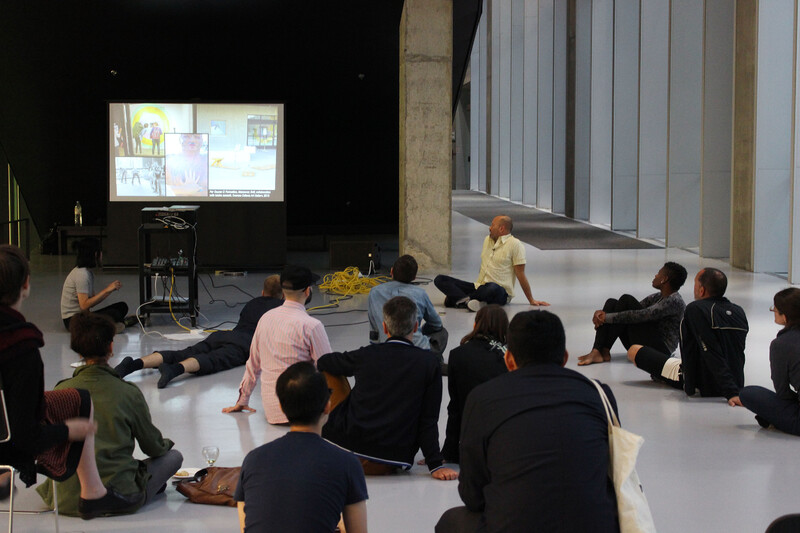The School for the Movement of the Technicolor People is a large-scale installation and performance platform that acts as a dance school. The School for the Movement of the Technicolor People responds to the limited positioning of Black and queer movers in the dance and art worlds amidst the evolving violence against Black bodies, gentrification, and the persistent erasure of communities of colour throughout history. This multidisciplinary platform is built from the dance company WXPT (We are the Paper, We are the Trees), which uses dance moves, protest forms, weight exchange, concealment strategies, and the everyday movement vocabularies of survival and celebration that structure Black and queer life. Heyward Bracey is a butoh influenced dancer/movement artist. Turay Turay is a performance artist and social justice advocate. Ashley Hunt is an image-maker, writer, and educator. Kim Zumpfe is an artist, educator, and sculptor. WXPT is an intentional community in the form of a dance company.
Heyward Bracey—a butoh influenced dancer/movement artist—has worked and performed with a number of experimental dance collectives including Corpus Delicti, Body Weather Laboratory, Los Angeles Movement Arts, and, most recently, WXPT - The School for the Movement of the Technicolor People. He has collaborated with master butoh artist Katsura Kan in Los Angeles, New York, and at the Seattle International Dance Festival. His recent solo, Stealing Skin 6, was presented at the Bare Bones Butoh Showcase in San Francisco, Pieter Performance Space in Los Angeles, and Central Cultural Los Talleres in Mexico City. Heyward's interest in the body as a social/political/spiritual process has led to recent collaborations with Emily Mast in The Least Important Things, presented at the Los Angeles County Museum of Art and The Cage is a Stage, presented at University of Toronto Mississauga, the Harbourfront Centre Theatre, Toronto, and the REDCAT, Los Angeles.
Ashley Hunt uses photography, the moving image, performance, map-making, and writing to engage social movements, the exercise of political power, and the disciplinary boundaries that separate art worlds from the larger worlds in which they sit. The bulk of his art-making documents the expansion of the US prison system and its effects on communities as one way to address structures that either allow some people to accumulate power or keep others from getting power, while learning from the ways people come to know, contribute to, or resist these structures. Hunt’s work has been exhibited in venues ranging from DiverseWorks (Houston), MoMA, Tate Modern, Documenta 12, and Project Row Houses in Houston through to community centers and prisons. Hunt is the Co-Director of the Program in Photography and Media at CalArts and is on the Visual Art faculty of Vermont College of Fine Arts.
Turay Turay (pronouns they, them, and theirs) is a Black, queer, gender non-conforming performance artist and social justice advocate. Their communion with dance has been mostly a private practice of transformative healing. Turay has been in a movement practice with WXPT, March 2015, as a means of affirming and further exploring their relationship to dance. Turay comes to their practice as a means of radical self-care.
Kim Zumpfe is an artist and educator who lives and works in Los Angeles. Her work moves and negotiates between bodies, objects, and politicized space - to interrogate encounters where there is a collapse of identity, intimacy, and power structures. She investigates the self within constructed sites and architectures, spaces and where multiple bodies develop, displace, produce, and forget to maintain boundaries and relations. Her work investigates the possibilities of where borders within these forms disperse through engagement with various media, including images, sculpture, video, installation, sound, and performance. Within her collaborations and individual work, she works to expand the potentials of resistance by producing psychological spaces that contain porosities of bent time(s) including the provisional, temporary, transient, unstable, and the illegible. Zumpfe’s work has been exhibited at Los Angeles Contemporary Exhibitions (LACE), UCR Culver Center for the Arts Riverside, DiverseWorks, University Art Gallery Irvine, Visual Arts Center Fullerton, University Art Museum Long Beach, and several public and online sites. She is a member of Emily O, a free-floating artist collective that questions the relationship between individual and collective processes and identity through organizing exhibitions and collaborative writing.

